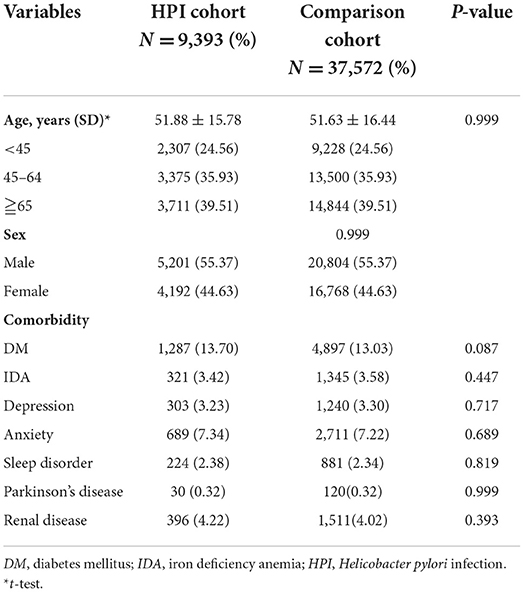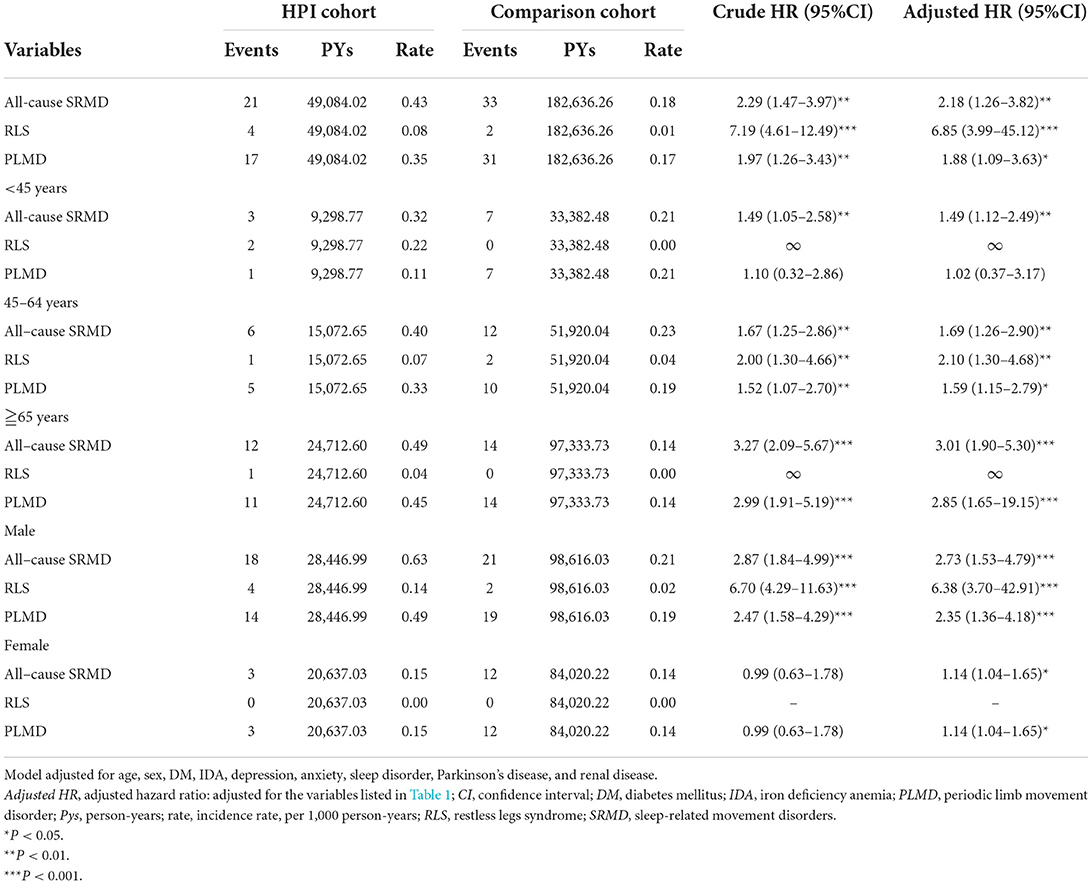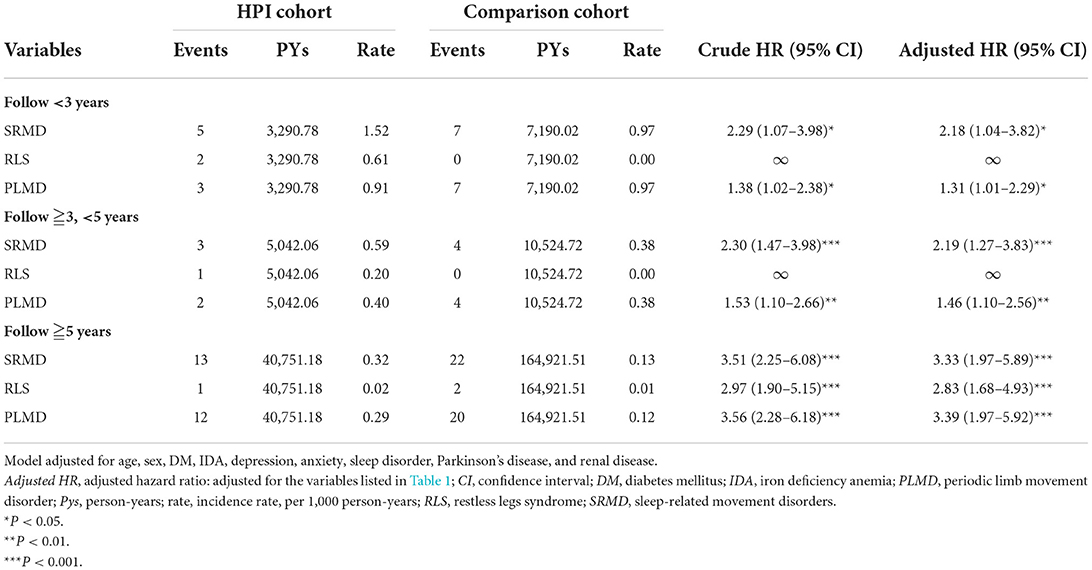- 1Department of Neurology, Tri-Service General Hospital, National Defense Medical Center, Taipei, Taiwan
- 2Department of Internal Medicine, Taipei Veterans General Hospital, Hsinchu, Taiwan
- 3Graduate Institute of Medical Sciences, National Defense Medical Center, Taipei, Taiwan
- 4Department of Neurology, Cardinal Tien Hospital, New Taipei City, Taiwan
- 5Department of Hyperbaric Medicine, Cardinal Tien Hospital, New Taipei City, Taiwan
- 6School of Medicine, Fu-Jen Catholic University, New Taipei City, Taiwan
- 7Taiwanese Injury Prevention and Safety Promotion Association, Taipei, Taiwan
- 8School of Public Health, National Defense Medical Center, Taipei, Taiwan
- 9Department of Medical Research, Tri-Service General Hospital, National Defense Medical Center, Taipei, Taiwan
Background and purpose: Evidence increasingly suggests that Helicobacter pylori infection (HPI) is associated with movement disorders such as Parkinson's disease (PD). However, the relationship between HPI and sleep-related movement disorders (SRMD) remains unknown. This nationwide population-based study tried to demonstrate whether patients with HPI have a higher risk of developing SRMD in a general adult population.
Methods: The study cohort enrolled 9,393 patients who were initially diagnosed with HPI between 2000 and 2013. Notably, 37,572 age- and sex-matched controls without prior HPI were selected as the reference. A Cox proportional hazard regression analysis was performed for multivariate adjustment.
Results: Patients with HPI had a higher risk of developing SRMD (adjusted hazard ratio [HR] = 2.18, 95% confidence interval [CI] = 1.26–3.82, p < 0.01). Patients with HPI aged ≥65 years exhibited the highest risk (HR = 3.01, 95% CI = 1.90–5.30, p < 0.001), followed by patients aged 45–64 years (HR = 1.69, 95% CI = 1.26–2.90, p <0.01) and <45 years (HR = 1.49, 95% CI = 1.12–2.49, p < 0.01). Patients were most likely to develop SRMD 5 years or more after diagnosis of HPI (HR = 3.33, 95% CI = 1.97–5.89, p < 0.001). The increased risk of SRMD in male patients with HPI (HR = 2.73, 95% CI = 1.53–4.79, p < 0.001) was greater than in female patients (HR = 1.14, 95% CI = 1.04–1.65, p < 0.05).
Conclusion: Patients with HPI were associated with an increased risk for SRMD, with a higher risk in men, aged ≥65 years, and diagnosed for more than 5 years.
Introduction
The dopaminergic system is involved in sleep-related movement disorders (SRMD) (1). Marked improvement was seen with dopamine agonists in patients with restless legs syndrome (RLS), who present an urge to move legs that worsens at night (2, 3). RLS-like symptoms produced with drugs that block the dopaminergic system also implicate the role of dopamine in RLS (4). The other most common SRMD is periodic limb movement disorder (PLMD), defined as leg movements seen by polysomnography and last 0.5–10 s occurring every 5–90 s (5). In patients with RLS or PLMD, a decreased number of striatal D2-receptors demonstrated by SPECT imaging, in addition to pharmacological evidence, suggests dopaminergic dysfunction (6).
Evidence increasingly suggests that Helicobacter pylori infection (HPI) is associated with Parkinson's disease (PD). Chronic HPI may predispose people to idiopathic PD, and a higher prevalence of HPI has been reported in patients with PD (7, 8). HPI affects levodopa absorption, and its eradication was approved to improve clinical response to levodopa (9). Screening and eradication of HPI have been recommended, particularly for PD patients with erratic response to levodopa (10). HPI may alter levodopa absorption, reducing the effectiveness of the medication for PD, which may also affect the response to dopaminergic agents for patients with SRMD. Additionally, inflammatory factors such as IL-6 and TNF-alpha, induced by chronic infection such as HPI, can lead to the destruction of dopaminergic neurons (11, 12). Therefore, it has been proposed that gut microflora, including Helicobacter pylori may produce metabolites, trigger neuroinflammation, and affect the dopaminergic system by crossing the gut-brain axis (13, 14). Notably, in a mouse model of HPI, women with HPI-associated chronic gastritis had lower activity and forelimb lift counts, as well as prolonged sleep latency and shortened sleep duration (15).
The prevalence of HPI in Taiwan was 53.9%, and it remains high in most developing countries (16). A recent prospective study suggested that HPI was related to the occurrence of RLS (17), but patients with other SRMD were not included. A large-scale longitudinal study is essential for providing epidemiological evidence of the relationship between HPI and SRMD before effective management, such as HPI eradication, is recommended. This is the first study investigating the association between HPI with both RLS and PLMD. It aims to ascertain whether patients with HPI have an elevated risk of developing SRMD during more than 5 years of follow-up, using data from the Taiwan National Health Insurance Research Database (NHIRD).
Materials and methods
Data source
The study was conducted using the data deduced from the Longitudinal Health Insurance Database (LHID), which is a sub-database of the Taiwan National Health Insurance (NHI) program covering over 99% of 23 million citizens. The LHID contains records on inpatients, outpatients, and ambulatory care services from 2000 to 2013. The diagnostic coding system was the International Classification of Diseases, Ninth Revision, Clinical Modification (ICD-9-CM). The data have been de-identified before releasing for research.
Study sample
The study group and a comparison reference cohort were selected from the LHID (Figure 1). The study group comprised all patients who had been diagnosed with HPI based on ICD-9-CM code 041.86 for the first time from 2000 to 2013 (N = 9,393). In Taiwan, HPI is diagnosed during endoscopy by the rapid urease test or histologic analysis. HPI is usually treated with triple eradication therapy (amoxicillin/metronidazole, levofloxacin/clarithromycin, and a proton pump inhibitor) for at least 2 weeks to help prevent the bacteria from developing resistance to one particular antibiotic. Patients aged under 20 years and patients with a diagnosis of SRMD before or within 6 months after confirmation of HPI were excluded. The index date of the HPI cohort was the first date of diagnosis of HPI. We randomly selected 37,572 subjects (a sample size 4-fold that of the HPI group), and the index date of these age- and sex-matched comparison cohorts was randomly assigned a month and a day in the same year as the matched cases. Each patient was followed up from the index date until the diagnosis date of SRMD. For those who did not have SRMD, the last day of follow-up was defined as the date of insurance withdrawal or the last day of the study period (31 December 2013).
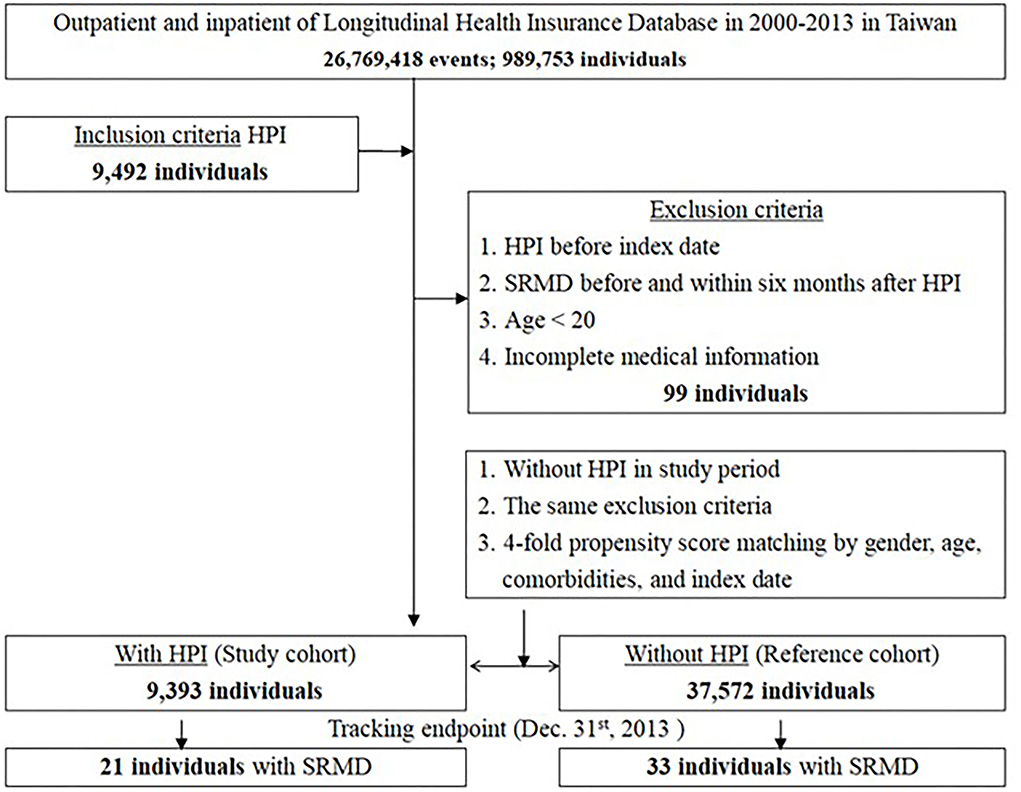
Figure 1. The flowchart of study sample selection from The National Health Insurance Research Database in Taiwan.
Definitions of SRMD by ICD classification
The diagnosis of SRMD was based on ICD-9-CM codes 327.5 (PLMD) and 333.9 (RLS). In Taiwan, the diagnosis of SRMD was made by board-certified neurologists. The diagnosis of RLS was made according to the consensus clinical features of RLS as delineated by the International Restless Legs Syndrome Study Group (IRLSSG) (18, 19). The diagnosis of PLMD was made based on the diagnostic criteria in the International Classification of Sleep Disorders (5). The SRMD-associated comorbidity was defined as the individual with a history of the comorbidity before the index date, and it included diabetes mellitus (DM, ICD-9-CM 250), iron deficiency anemia (IDA, ICD-9-CM 280), depression (ICD-9-CM 296.2, 296.3, 300.4, and 311), anxiety (ICD-9-CM 300.00), sleep disorder (ICD-9-CM 307.4, 780.5), Parkinson's disease (ICD-9-CM 332), and renal disease (ICD-9-CM 580-589).
Statistical analysis
Continuous variables were presented as mean and standard deviation (SD) and categorical variables as numbers and percentages. Differences between study and comparison cohorts in the distribution of demographic characteristics and comorbidities were examined by t-test (for age) and chi-square test (for sex and comorbidities). The incidence density of SRMD was measured for HPI and comparison cohorts, and the total SRMD events were divided by the total sum of follow-up years (per 1,000 person-years). Cox proportional hazard regression analysis was performed to calculate adjusted hazard ratios (HR), with 95% confidence intervals (CI), for SRMD risk between the two cohorts. To investigate the interaction of covariates in relation to the association between HPI and SRMD, we calculated adjusted HR stratified by age (< 45, 45–64, and ≥65 years), sex, and follow-up time. We also measured and compared the cumulative incidence curves between HPI and comparison cohorts by the Kaplan-Meier method and tested the curve differences by the log-rank test. All statistical analyses were performed using the SPSS software version 22.0. A 2-tailed P-value of less than 0.05 was considered statistically significant.
Results
A total of 9,393 patients diagnosed with HPI and 37,572 age- and sex-matched controls for reference were included in this cohort study. The demographic characteristics of both groups are presented in Table 1. There were no significant differences in the distribution of age, sex, and comorbidities between the study group with HPI and the comparison cohort. The mean age of both cases and their controls was about 51 years on the index date, and most participants in the two cohorts were men (55.37%).
Our data showed that over a 10-year follow-up on average, 21 patients with HPI developed SRMD with an overall rate of 0.43 cases per 1,000 person-years, of which 4 were RLS and 17 were PLMD. In the comparison cohort, 33 patients without HPI developed SRMD with an overall rate of 0.18 cases per 1,000 person-years, and 2 and 31 were RLS and PLMD, respectively. The results revealed that patients with HPI had a 2.18 times (95% CI = 1.26–3.82, p < 0.01) higher risk of developing SRMD compared to individuals without HPI (Table 2). To explore whether HPI is an age-dependent risk factor for SRMD, patients were divided into 3 groups, namely, <45, 45–64, and ≥65 years. The results showed that in comparison with age/sex matched controls, HPI patients aged ≥65 years exhibited the highest risk of developing SRMD (HR = 3.01, 95% CI = 1.90–5.30, p < 0.001), followed by patients aged 45–64 years (HR = 1.69, 95% CI = 1.26–2.90, p < 0.01), and <45 years (HR = 1.49, 95% CI = 1.12–2.49, p < 0.01). We also examined if HPI is a sex-dependent risk factor for SRMD. The Cox regression analysis revealed that the increased risk of SRMD in male patients with HPI (HR = 2.73, 95% CI = 1.53–4.79, p < 0.001) was greater than in female patients (HR = 1.14, 95% CI = 1.04–1.65, p < 0.05).
We further analyzed the incidence of SRMD and SRMD subtypes using multivariate Cox proportional hazards regression analysis based on time intervals. Table 3 shows the impact of follow-up time on the risk of developing SRMD. Patients were most likely to develop SRMD after diagnosis of HPI for 5 years (SRMD, HR = 3.33, 95% CI = 1.97–5.89, p < 0.001; RLS, HR = 2.83, 95% CI = 1.68–4.93, p < 0.001; PLMD, HR = 3.39, 95% CI = 1.97–5.92, p < 0.001) (Table 3). Relatively, the risks for patients with HPI of developing SRMD were both about two times higher than controls in the groups with a follow-up time within 3 and between 3 and 5 years (HR = 2.18, 95% CI = 1.04–3.82, p < 0.05 and HR = 2.19, 95% CI = 1.27–3.83, p < 0.001, respectively) (Table 3). Kaplan–Meier analysis showed that, compared to the matched controls, patients with HPI had a significantly higher incidence of SRMD (log-rank test p= 0.001, Figure 2A), RLS (log-rank test p=0.006, Figure 2B), and PLMD (log-rank test p = 0.012, Figure 2C).
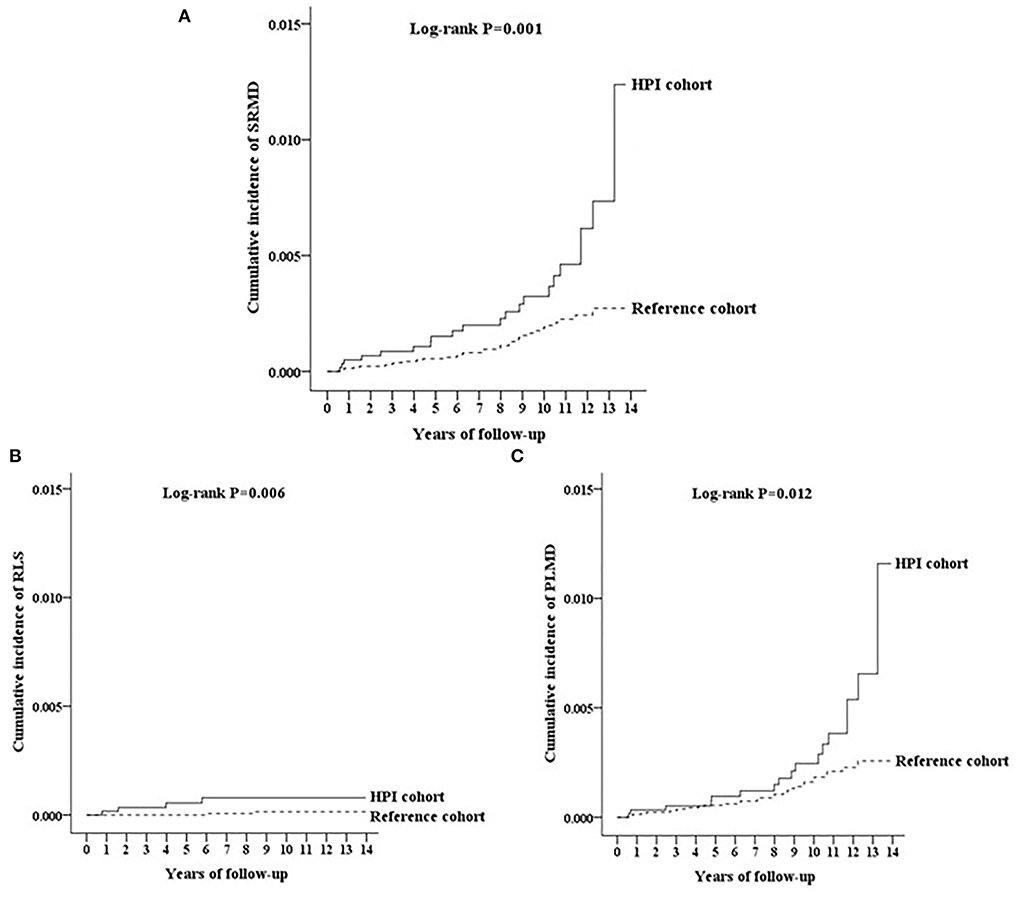
Figure 2. (A) The cumulative incidence curves of sleep-related movement disorders (SRMD) for individuals with and without Helicobacter pylori infection (HPI). (B) The cumulative incidence curves of restless legs syndrome (RLS) for individuals with and without HPI. (C) The cumulative incidence curves of periodic limb movement disorder (PLMD) for individuals with and without HPI.
Discussion
In this nationwide population-based study, we found that patients with HPI had a significantly higher risk of developing subsequent SRMD. Patients with HPI aged ≥65 years, compared to the other age groups, were at the highest risk of developing RLS and PLMD, the most common types of SRMD. The increased risk of SRMD in male patients with HPI was greater than in female patients. Furthermore, patients were most likely to develop SRMD 5 years or more after diagnosis of HPI, suggesting that chronic infection due to an intestinal bacterial overgrowth is associated with the pathogenesis of SRMD.
The pathogenesis of RLS and other SRMD could be partially attributed to an immune reaction to gastrointestinal bacteria, leading to an immunological attack on the nervous system (20). Chronic neuroinflammation in the central nervous system may therefore result in iron deficiency-induced RLS (21). It has been reported that patients who lack ferritin light chain (FTL), an abnormality in iron metabolism, experienced atypical restless legs syndrome (22). HPI has been suggested to be involved in the pathogenesis of sleep disorders such as obstructive sleep apnea, due to inflammatory cytokines which result in neuropsychological impairment (23–25). Herein, we first provide evidence that HPI is associated with the development of subsequent SRMD.
This study demonstrated that patients with HPI had a 2.18 times (95% CI = 1.26–3.82) higher risk of developing SRMD compared to those without HPI. In comparison, a similarly high risk of PD in the HPI group (HR = 2.29, 95% CI = 1.44–3.66) was reported in a retrospective cohort study (26). We found that people of different ages are differentially influenced by HPI to develop subsequent SRMD, and patients with HPI aged ≥65 years exhibited the highest risk of developing SRMD (HR = 3.01, 95% CI = 1.90–5.30). Similarly, HPI was previously found to be significantly associated with an increased risk of PD among individuals aged 60 years and older (HR = 2.53, 95% CI = 1.47–4.35), but not among those younger than 60 years (26). Our age-stratified analysis suggests that the increased risk of RLS is more significant than PLMD among all age groups. But the numbers of RLS patients were too small to conduct further statistical analysis. In addition, our results showed that patients were most likely to develop SRMD, especially PLMD, after diagnosis of HPI for 5 years or more. In fact, chronic HPI has been demonstrated to induce the production of systemic pro-inflammatory cytokines that may cross the blood–brain barrier to cause a vicious cycle of uncontrolled neuroinflammation (27).
According to a recent meta-analysis, the odds ratio of PD for those with HPI was 1.59 (95% CI = 1.37–1.85), compared to individuals without HPI (8). In contrast, an earlier review reported that the prevalence of HPI in patients with PD in four studies ranged from 37% to 59%, which was similar to that of the general population (28). Moreover, only limited evidence could be provided in three randomized controlled trials (RCT) to support that HPI eradication alleviated motor symptoms in patients with PD (28). A wellconducted RCT with standard outcome measures and treatment is also required to demonstrate whether patients with HPI have a higher risk of developing subsequent SRMD.
Both RLS and PLMD have been demonstrated to be associated with an increased risk for stroke in our previous study (29). Chronic HPI has also been shown to increase the risk of acute ischemic stroke (OR = 2.57, 95% CI = 1.09–6.08) in the Fukuoka Harasanshin Atherosclerosis Trial (30). A future study will demonstrate whether patients with HPI have an even higher risk of stroke when they develop SRMD due to hypothetical neuroinflammation and dysfunction of the dopaminergic system and show if HPI eradication for patients with SRMD can reduce the risk of subsequent stroke.
In contrast with a prospective study of a smaller scale on the relationship between HPI and occurrence of RLS (17), the diagnosis of SRMD in this study was made based on standard criteria in our nationwide health care system, with the correctly collected time interval between diagnosis of HPI and subsequent SRMD (2, 29). This partially accounts for a relatively low prevalence of SRMD in our population, suggesting that the disease state of SRMD may be more advanced and detectable by polysomnography than those evaluated by primary screening instruments in other studies.
There are several limitations to this study. First, neither different severities of SRMD nor health information such as intensity of tobacco use, alcohol consumption, and diet that may influence the risk of SRMD and HPI could be provided by the database. Some potential risk factors for SRMD, such as genetic background and family history of SRMD, were not available. Second, HPI may or may not produce any clinical symptoms, and most endoscopy and tissue biopsy for HPI are performed when people report symptoms. Therefore, some patients may be underdiagnosed and recruited into the matched controls. Furthermore, we did not know if the patients were treated completely or declared cured of HPI. In fact, the recurrence of HPI is not rare, which can be caused by recrudescence and reinfection (31). Finally, the data may also include unidentified recurrent patients who had SRMD and HPI before 1996 when NHI was enacted (32). Nevertheless, we only included patients with new incidences of HPI and SRMD to increase the accuracy of the diagnoses. The criteria in this study depended on ICD codes, which may be different from other studies, and the NHI administration has a cross-checking system to continuously evaluate the precision of records (33).
Conclusion
Helicobacter pylori infection was demonstrated to be associated with an increased risk of subsequent SRMD such as RLS and PLMD in this study. Patients with HPI aged ≥65 years exhibited the greatest risk of developing SRMD. Patients were most likely to develop SRMD after diagnosis of HPI for 5 years or more. It suggests that chronic inflammation after HPI is associated with the pathogenesis of SRMD, especially in the vulnerable group in which patients are older and potentially have an underlying neurodegenerative disease. Further research is required to explore whether effective practices, such as HPI eradication, can reduce the risk of developing SRMD.
Data availability statement
The original contributions presented in the study are included in the article/supplementary material, further inquiries can be directed to the corresponding author.
Ethics statement
This study protocol was reviewed by Institutional Review Board of TriService General Hospital (TSGHIRB No.: 2-104-05-045). Written informed consent from the patients/participants or patients/participants' legal guardian/next of kin was not required to participate in this study in accordance with the national legislation and the institutional requirements.
Author contributions
Y-FS, J-HY, K-HL, C-HCho, J-TL, C-LT, C-HChu, and W-CC contributed substantially to the research concept and design, acquisition, analysis, and interpretation of data. C-HCho, K-HL, Y-KL, S-YC, and Y-FS drafted and revised the manuscript to be published. All authors contributed to the article and approved the submitted version.
Funding
This study was supported by grants from the Ministry of Science and Technology Taiwan (MOST-109-2314-B-016-008), the Ministry of National Defense Medical Affairs Bureau (MND-MAB-C06-112025, MNDMAB-C-111-07-111028, and MND-MAB-C07-111028), and Tri-Service General Hospital (TSGH-E-111228, TSGH-E-110196, TSGH-E-109226, and TSGH-C108-006-007-007-S05). The funders had no role in study design, data collection and analysis, decision to publish, or preparation of the manuscript.
Conflict of interest
The authors declare that the research was conducted in the absence of any commercial or financial relationships that could be construed as a potential conflict of interest.
Publisher's note
All claims expressed in this article are solely those of the authors and do not necessarily represent those of their affiliated organizations, or those of the publisher, the editors and the reviewers. Any product that may be evaluated in this article, or claim that may be made by its manufacturer, is not guaranteed or endorsed by the publisher.
References
1. Ferini-Strambi L, Carli G, Casoni F, Galbiati A. Restless legs syndrome and parkinson disease: a causal relationship between the two disorders? Front Neurol. (2018) 9:551. doi: 10.3389/fneur.2018.00551
2. Allen RP, Picchietti DL, Garcia-Borreguero D, et al. Restless legs syndrome/Willis-Ekbom disease diagnostic criteria: updated international restless legs syndrome study group (IRLSSG) consensus criteria–history, rationale, description, and significance. Sleep Med. (2014) 15:860–73. doi: 10.1016/j.sleep.2014.03.025
3. Tergau F, Wischer S, Wolf C, Paulus W. Treatment of restless legs syndrome with the dopamine agonist alpha-dihydroergocryptine. Mov Disord. (2001) 16:731–5. doi: 10.1002/mds.1141
4. Winkelmann J, Schadrack J, Wetter TC, Zieglgansberger W, Trenkwalder C. Opioid and dopamine antagonist drug challenges in untreated restless legs syndrome patients. Sleep Med. (2001) 2:57–61. doi: 10.1016/S1389-9457(00)00025-3
5. Littner MR, Kushida C, Anderson WM, et al. Practice parameters for the dopaminergic treatment of restless legs syndrome and periodic limb movement disorder. Sleep. (2004) 27:557–9. doi: 10.1093/sleep/27.3.557
6. Michaud M, Soucy JP, Chabli A, Lavigne G, Montplaisir J, SPECT SPECT imaging of striatal pre- and postsynaptic dopaminergic status in restless legs syndrome with periodic leg movements in sleep. J Neurol. (2002) 249:164–70. doi: 10.1007/PL00007859
7. Dobbs RJ, Charlett A, Dobbs SM, Weller C, Peterson DW. Parkinsonism: differential age-trend in Helicobacter pylori antibody. Aliment Pharmacol Ther. (2000) 14:1199–205. doi: 10.1046/j.1365-2036.2000.00815.x
8. Shen X, Yang H, Wu Y, Zhang D, Jiang H. Meta-analysis: association of Helicobacter pylori infection with Parkinson's diseases. Helicobacter. (2017) 22:e12398. doi: 10.1111/hel.12398
9. Hashim H, Azmin S, Razlan H, et al. Eradication of Helicobacter pylori infection improves levodopa action, clinical symptoms and quality of life in patients with Parkinson's disease. PLoS ONE. (2014) 9:e112330. doi: 10.1371/journal.pone.0112330
10. Liu H, Su W, Li S, et al. Eradication of Helicobacter pylori infection might improve clinical status of patients with Parkinson's disease, especially on bradykinesia. Clin Neurol Neurosurg. (2017) 160:101–4. doi: 10.1016/j.clineuro.2017.07.003
11. Dobbs RJ, Charlett A, Purkiss AG, Dobbs SM, Weller C, Peterson DW. Association of circulating TNF-alpha and IL-6 with ageing and parkinsonism. Acta Neurol Scand. (1999) 100:34–41. doi: 10.1111/j.1600-0404.1999.tb00721.x
12. Wang XM, Zhang YG Li AL, et al. Relationship between levels of inflammatory cytokines in the peripheral blood and the severity of depression and anxiety in patients with Parkinson's disease. Eur Rev Med Pharmacol Sci. (2016) 20:3853–6.
13. McGee DJ, Lu XH, Disbrow EA. Stomaching the possibility of a pathogenic role for Helicobacter pylori in Parkinson's disease. J Parkinsons Dis. (2018) 8:367–74. doi: 10.3233/JPD-181327
14. Gorle N, Bauwens E, Haesebrouck F, Smet A, Vandenbroucke RE. Helicobacter and the potential role in neurological disorders: there is more than Helicobacter pylori. Front Immunol. (2020) 11:584165. doi: 10.3389/fimmu.2020.584165
15. Liu H, Zheng W, Zhang L, Lin T, Tang Y, Hu L. Effect of Helicobacter pylori-associated chronic gastritis on autonomous activity and sleep quality in mice. Front Pharmacol. (2022) 13:785105. doi: 10.3389/fphar.2022.785105
16. Hooi JKY, Lai WY, Ng WK, et al. global prevalence of Helicobacter pylori infection: systematic review and meta-analysis. Gastroenterology. (2017) 153:420–9. doi: 10.1053/j.gastro.2017.04.022
17. Rezvani F, Sayadnasiri M, Rezaei O. Restless legs syndrome in patients infected with Helicobacter pylori. Neurol Res. (2018) 40:581–5. doi: 10.1080/01616412.2018.1454704
18. Walters AS. Toward a better definition of the restless legs syndrome. Int Restless Legs Synd Study Group Mov Disord. (1995) 10:634–42. doi: 10.1002/mds.870100517
19. Zucconi M, Ferri R, Allen R, et al. The official world association of sleep medicine (WASM) standards for recording and scoring periodic leg movements in sleep (PLMS) and wakefulness (PLMW) developed in collaboration with a task force from the international restless legs syndrome study group (IRLSSG). Sleep Med. (2006) 7:175–83. doi: 10.1016/j.sleep.2006.01.001
20. Weinstock LB, Walters AS, Paueksakon P. Restless legs syndrome—theoretical roles of inflammatory and immune mechanisms. Sleep Med Rev. (2012) 16:341–54. doi: 10.1016/j.smrv.2011.09.003
21. Hamed SA. Neurologic conditions and disorders of uremic syndrome of chronic kidney disease: presentations, causes, and treatment strategies. Expert Rev Clin Pharmacol. (2019) 12:61–90. doi: 10.1080/17512433.2019.1555468
22. Cozzi A, Santambrogio P, Privitera D, et al. Human L-ferritin deficiency is characterized by idiopathic generalized seizures and atypical restless leg syndrome. J Exp Med. (2013) 210:1779–91. doi: 10.1084/jem.20130315
23. Kountouras C, Polyzos SA, Stergiopoulos C, et al. A potential impact of Helicobacter pylori infection on both obstructive sleep apnea and atrial fibrillation-related stroke. Sleep Med. (2017) 34:256. doi: 10.1016/j.sleep.2017.03.010
24. Kountouras J, Polyzos SA, Deretzi G. Helicobacter pylori associated with obstructive sleep apnea might contribute to sleep, cognition, and driving performance disturbances in patients with cirrhosis. Clin Gastroenterol Hepatol. (2015) 13:1547. doi: 10.1016/j.cgh.2015.02.009
25. Stergiopoulos C, Kountouras J, Daskalopoulou-Vlachoyianni E, et al. Helicobacter pylori may play a role in both obstructive sleep apnea and metabolic syndrome. Sleep Med. (2012) 13:212–3. doi: 10.1016/j.sleep.2011.04.016
26. Huang HK, Wang JH, Lei WY, Chen CL, Chang CY, Liou LS. Helicobacter pylori infection is associated with an increased risk of Parkinson's disease: a population-based retrospective cohort study. Parkinsonism Relat Disord. (2018) 47:26–31. doi: 10.1016/j.parkreldis.2017.11.331
27. Park AM, Omura S, Fujita M, Sato F, Tsunoda I. Helicobacter pylori and gut microbiota in multiple sclerosis versus Alzheimer's disease: 10 pitfalls of microbiome studies. Clin Exp Neuroimmunol. (2017) 8:215–32. doi: 10.1111/cen3.12401
28. Rees K, Stowe R, Patel S, et al. Helicobacter pylori eradication for Parkinson's disease. Cochrane Database Syst Rev. (2011) 2011:CD008453. doi: 10.1002/14651858.CD008453.pub2
29. Chou CH, Yin JH, Chen SY, et al. The potential impact of sleep-related movement disorders on stroke risk: a population-based longitudinal study. QJM. (2017) 110:649–55. doi: 10.1093/qjmed/hcx097
30. Sawayama Y, Ariyama I, Hamada M, et al. Association between chronic Helicobacter pylori infection and acute ischemic stroke: fukuoka harasanshin atherosclerosis Trial (FHAT). Atherosclerosis. (2005) 178:303–9. doi: 10.1016/j.atherosclerosis.2004.08.025
31. Sjomina O, Pavlova J, Niv Y, Leja M. Epidemiology of Helicobacter pylori infection. Helicobacter. (2018) 23 Suppl 1:e12514. doi: 10.1111/hel.12514
32. Cheng TM. Reflections on the 20th anniversary of Taiwan's single-payer national health insurance system. Health Aff. (2015) 34:502–10. doi: 10.1377/hlthaff.2014.1332
Keywords: sleep-related movement disorders, restless legs syndrome, periodic limb movement disorder, Helicobacter pylori, movement disorder
Citation: Sung Y-F, Yin J-H, Lee K-H, Tsai C-L, Lin Y-K, Chen S-Y, Chung C-H, Chien W-C, Lee J-T and Chou C-H (2022) Increased risk of sleep-related movement disorder in patients with Helicobacter pylori infection: A nationwide population-based study. Front. Neurol. 13:953821. doi: 10.3389/fneur.2022.953821
Received: 26 May 2022; Accepted: 20 September 2022;
Published: 10 October 2022.
Edited by:
Keisuke Suzuki, Dokkyo Medical University, JapanReviewed by:
Kye Won Park, University of British Columbia, CanadaAlbert Stezin, Indian Institute of Science, India
Copyright © 2022 Sung, Yin, Lee, Tsai, Lin, Chen, Chung, Chien, Lee and Chou. This is an open-access article distributed under the terms of the Creative Commons Attribution License (CC BY). The use, distribution or reproduction in other forums is permitted, provided the original author(s) and the copyright owner(s) are credited and that the original publication in this journal is cited, in accordance with accepted academic practice. No use, distribution or reproduction is permitted which does not comply with these terms.
*Correspondence: Chung-Hsing Chou, Y2hvdXRwZUB5YWhvby5jb20udHc=
 Yueh-Feng Sung
Yueh-Feng Sung Jiu-Haw Yin1,2
Jiu-Haw Yin1,2 Yu-Kai Lin
Yu-Kai Lin Chi-Hsiang Chung
Chi-Hsiang Chung Wu-Chien Chien
Wu-Chien Chien Jiunn-Tay Lee
Jiunn-Tay Lee Chung-Hsing Chou
Chung-Hsing Chou